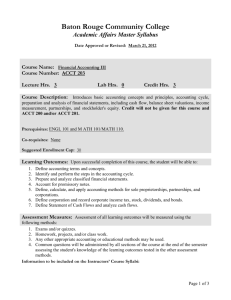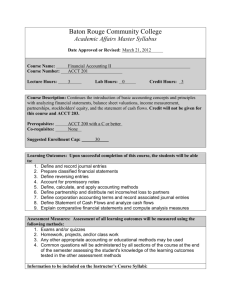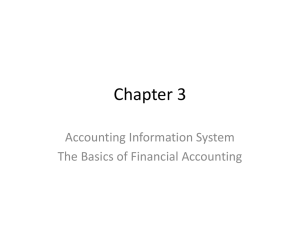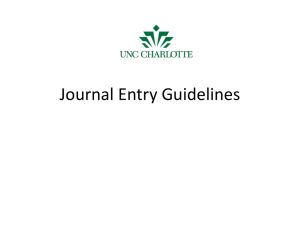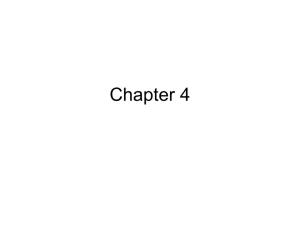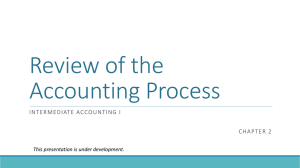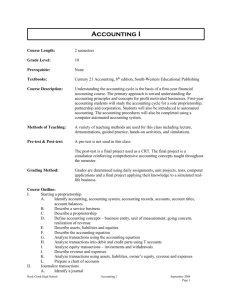1111528128_324748
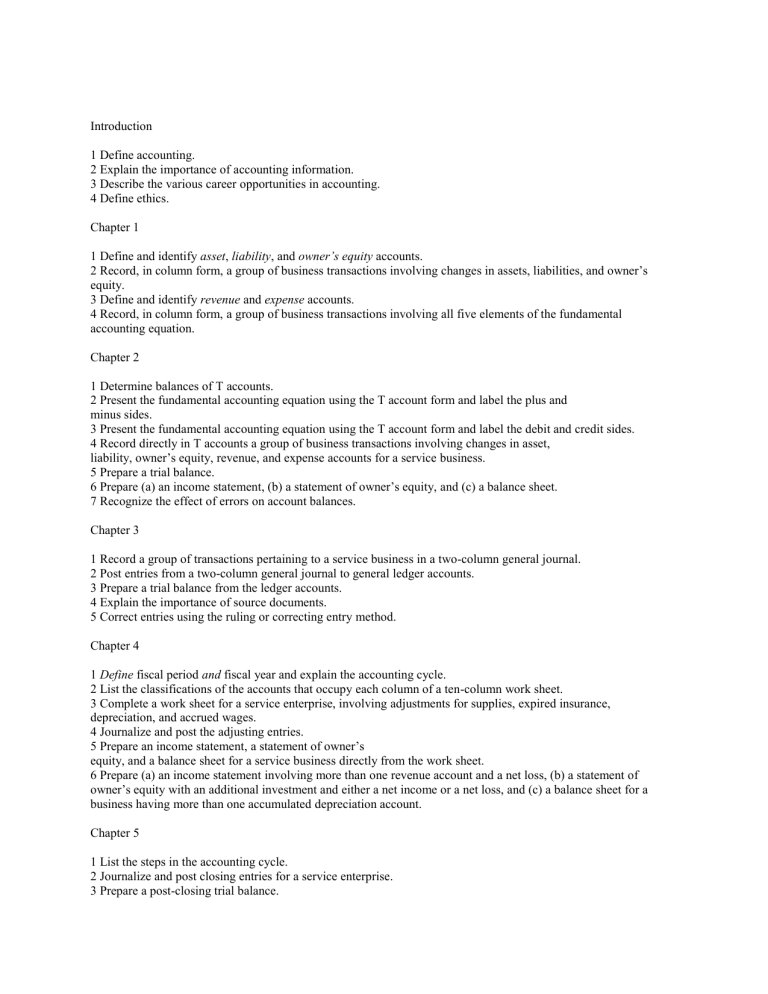
Introduction
1 Define accounting.
2 Explain the importance of accounting information.
3 Describe the various career opportunities in accounting.
4 Define ethics.
Chapter 1
1 Define and identify asset , liability , and owner’s equity accounts.
2 Record, in column form, a group of business transactions involving changes in assets, liabilities, and owner’s equity.
3 Define and identify revenue and expense accounts.
4 Record, in column form, a group of business transactions involving all five elements of the fundamental accounting equation.
Chapter 2
1 Determine balances of T accounts.
2 Present the fundamental accounting equation using the T account form and label the plus and minus sides.
3 Present the fundamental accounting equation using the T account form and label the debit and credit sides.
4 Record directly in T accounts a group of business transactions involving changes in asset, liability, owner’s equity, revenue, and expense accounts for a service business.
5 Prepare a trial balance.
6 Prepare (a) an income statement, (b) a statement of owner’s equity, and (c) a balance sheet.
7 Recognize the effect of errors on account balances.
Chapter 3
1 Record a group of transactions pertaining to a service business in a two-column general journal.
2 Post entries from a two-column general journal to general ledger accounts.
3 Prepare a trial balance from the ledger accounts.
4 Explain the importance of source documents.
5 Correct entries using the ruling or correcting entry method.
Chapter 4
1 Define fiscal period and fiscal year and explain the accounting cycle.
2 List the classifications of the accounts that occupy each column of a ten-column work sheet.
3 Complete a work sheet for a service enterprise, involving adjustments for supplies, expired insurance, depreciation, and accrued wages.
4 Journalize and post the adjusting entries.
5 Prepare an income statement, a statement of owner’s equity, and a balance sheet for a service business directly from the work sheet.
6 Prepare (a) an income statement involving more than one revenue account and a net loss, (b) a statement of owner’s equity with an additional investment and either a net income or a net loss, and (c) a balance sheet for a business having more than one accumulated depreciation account.
Chapter 5
1 List the steps in the accounting cycle.
2 Journalize and post closing entries for a service enterprise.
3 Prepare a post-closing trial balance.
4 Define cash basis and accrual basis accounting.
5 Prepare interim statements.
Chapter 6
1 List internal controls for cash receipts and cash payments.
2 Describe the procedures for recording deposits and withdrawals.
3 Reconcile a bank statement.
4 Record the required journal entries from the bank reconciliation.
5 Record journal entries to establish a Petty Cash Fund.
6 Complete petty cash vouchers, petty cash payments record and reimburse the petty cash fund.
7 Record the journal entries to establish a Change Fund.
8 Record journal entries for transactions involving Cash Short and Over.
Chapter 7
1 Recognize the role of income tax laws that affect payroll deductions and contributions.
2 Calculate total earnings based on an hourly, salary, piece-rate, or commission basis.
3 Determine deductions from gross pay, such as federal income tax withheld, Social Security tax, and Medicare tax, to calculate net pay.
4 Complete a payroll register.
5 Journalize the payroll entry from a payroll register.
6 Maintain employees’ individual earnings records.
Chapter 8
1 Calculate the amount of payroll tax expense and journalize the entry.
2 Journalize the entry for the deposit of employees’ federal income taxes withheld and
FICA taxes (both employees’ withheld and employer’s share) and prepare the deposit.
3 Journalize the entries for the payment of employer’s state and federal unemployment taxes.
4 Journalize the entry for the deposit of employees’ state income taxes withheld.
5 Complete Employer’s Quarterly Federal Tax Return, Form 941.
6 Prepare W-2 and W-3 forms and Form 940.
7 Calculate the premium for workers’ compensation insurance and prepare the entry for payment in advance.
8 Determine the amount of the end-of-the-year adjustments for (a) workers’ compensation insurance and (b) accrued salaries and wages and record the adjustments.
Chapter 9
1 Describe the nature of a merchandising business.
2 Using a general journal and the periodic inventory system, record sales and sale-related transactions; then post to the general ledger and the accounts receivable ledger.
3 Prepare a schedule of accounts receivable.
4 Using a general journal and the periodic inventory system, record purchase and purchase-related transactions; then post to the general ledger and the accounts payable ledger.
5 Prepare a schedule of accounts payable.
6 Using a general journal and the perpetual inventory system, record sales and sale-related transactions.
7 Using a general journal and the perpetual inventory system, record purchase and purchase-related transactions.
8 Record transactions in a sales journal and post to the general ledger and accounts receivable ledger.
9 Record transactions in a three-column purchases journal and post to the general ledger and accounts payable ledger.
Chapter 10
1 Determine cash discounts according to credit terms.
2 In the general journal, record sales transactions involving cash receipts and cash discounts.
3 In the general journal, record purchase transactions involving cash payments and cash discounts.
4 Record transactions involving trade discounts.
5 In the cash receipts journal, record transactions for a merchandising business and post from a cash receipts journal to a general ledger and an accounts receivable ledger.
6 In the cash payments journal, record transactions for a merchandising business and post from a cash payments journal to a general ledger and an accounts payable ledger.
Chapter 11
1 Prepare an adjustment for unearned revenue.
2 Prepare an adjustment for merchandise inventory under the periodic inventory system.
3 Record adjustment data in a work sheet including merchandise inventory, unearned revenue, supplies used, expired insurance, depreciation, and accrued wages or salaries.
4 Complete the work sheet.
5 Journalize the adjusting entries for a merchandising business under the periodic inventory system.
6 Prepare and journalize the adjusting entry for merchandise inventory under the perpetual inventory system.
Chapter 12
1 Prepare a classified income statement for a merchandising firm.
2 Prepare a classified balance sheet for any type of business.
3 Compute working capital and current ratio.
4 Record the closing entries for a merchandising firm.
5 Determine which adjusting entries can be reversed and record the reversing entries.
Chapter 13
1 Define promissory note .
2 Calculate the interest on promissory notes.
3 Determine the due dates of promissory notes.
4 Make journal entries for (a) notes given to secure an extension of time on an open account; (b) payment of an interest-bearing note at maturity; (c) notes given in exchange for merchandise or other property purchased;
(d) notes given to secure a cash loan when the borrower receives the full face value of the note;
(e) notes given to secure a cash loan when the bank discounts the note; (f) payment of a discounted note at maturity; and (g) renewal of a note at maturity.
5 Complete a notes payable register.
6 Make adjusting journal entries for accrued interest on notes payable.
Chapter 14
1 Record the journal entries for (a) receipt of a note from a charge customer,
(b) receipt of payment of an interest-bearing note at maturity, (c) receipt of a note as a result of granting a personal loan, (d) receipt of a note in exchange for merchandise or other property,
(e) renewal of a note at maturity and receipt of interest, (f) renewal of a note with receipt of interest and partial receipt of principal, (g) a dishonored note receivable, (h) collection of a note receivable formerly dishonored, and
(i) discounting an interest-bearing note receivable.
2 Complete a notes receivable register.
3 Record the adjusting journal entry for accrued interest on notes receivable.
Chapter 15
1 Describe the two methods used when accounting for uncollectible accounts.
2 Record the adjusting entry to estimate Bad Debts Expense by using the allowance method. (a) Determine the amount of the adjusting entry by aging Accounts Receivable. (b) Determine the amount of the adjusting entry by using a percentage of Accounts Receivable. (c) Calculate the amount of the adjusting entry by using a percentage of net sales or net credit sales.
3 Record the write-off of uncollectible accounts receivable using the allowance method.
4 Record the reinstatement of accounts receivable previously written off using the allowance method.
5 Record the write-off of uncollectible accounts receivable using the specific charge-off method.
6 Record the reinstatement of accounts receivable previously written off using the specific charge-off method.
Chapter 16
1 Determine the overstatement or understatement of cost of goods sold, gross profit, and net income resulting from a change in the ending merchandise inventory amount.
2 Determine the unit cost, the value of the ending inventory, and the cost of goods sold under the periodic inventory system by the following methods: (a) specific identification; (b) weighted-averagecost; (c) first-in, first-out; and (d) last-in, first-out.
3 Determine the unit cost, the value of ending inventory, and the cost of goods sold under the perpetual inventory system by the following methods: (a) moving-average-cost method and (b) last-in, first-out method.
4 Complete a perpetual inventory record card.
Chapter 17
1 Identify and record the different types of property and equipment.
2 Allocate costs to Land and Buildings for a lump-sum purchase.
3 Calculate depreciation by using the (a) straight-line method, (b) double declining-balance method, (c) units-ofproduction method, and (d) MACRS method.
4 Differentiate among capital expenditures, revenue expenditures, and extraordinary-repairs expenditures.
5 Prepare journal entries for (a) discarding, (b) selling, and (c) exchanging assets.
6 Describe the importance of property and equipment records.
7 Identify and record the different types of intangibles.
Chapter 18
1 (a) Define the various kinds of partnerships and list the main advantages and disadvantages of a partnership; (b) journalize initial investments of a partnership.
2 Provide for the division of net income or loss of a partnership on the basis of (a) fractional shares, (b) ratio of capital investments, and (c) salary and interest allowances.
3 Journalize the closing entries for a partnership on the basis of (a) fractional shares, (b) ratio of capital investments, and (c) salary and interest allowances.
4 Prepare a statement of partners’ equity.
5 Journalize entries involving the sale of a partnership interest or withdrawal of a partner.
6 Journalize entries pertaining to the liquidation of a partnership involving the immediate sale of the assets for cash.
Chapter 19
1 Define corporation.
2 Name advantages and disadvantages of the corporate form of business.
3 Describe the formation of a corporation.
4 Journalize entries for the issuance of par-value stock.
5 Journalize entries for the issuance of no-par-value stock.
6 Journalize entries for the sale of stock on the subscription basis.
7 Prepare a classified balance sheet for a corporation, including Subscriptions Receivable, Paid-in Capital, and
Retained Earnings accounts.
Chapter 20
1 Calculate corporate income tax.
2 Journalize entries for corporate income taxes.
3 Journalize closing entries for a corporation.
4 Journalize entries for the declaration and payment of cash dividends.
5 Calculate dividends on cumulative preferred stock.
6 Journalize entries for the declaration and issuance of stock dividends.
7 Journalize entries for the appropriation of Retained Earnings.
8 Complete a corporate statement of retained earnings and a balance sheet, including the following types of accounts: Appropriated Retained Earnings, Stock Dividend Distributable, Dividends Payable, and Income Tax
Payable.
9 Describe guidelines for accounting reports.
Chapter 21
1 Classify bonds and describe the advantages and disadvantages of issuing bonds compared with issuing stock.
2 Journalize transactions involving the issuance of bonds at a premium or discount and the interest payment on bonds.
3 Journalize adjusting entries for amortization of bond premiums and discounts and for accrued interest payable.
4 Journalize entries pertaining to the establishment of a bond sinking fund, the receipt of income from sinking fund investments, and the eventual payment of the principal of the bonds.
5 Journalize transactions involving the redemption of bonds.
Chapter 22
1 Describe the statement of cash flows and define cash and cash equivalents .
2 State the purpose of the statement of cash flows.
3 State the uses of the statement of cash flows by management, investors, and creditors.
4 Identify cash inflows and outflows as operating, investing, or financing activities.
5 Prepare the Operating
Activities section of the statement of cash flows using the indirect method.
6 Prepare the Investing Activities and Financing Activities sections of the statement of cash flows.
7 Prepare a schedule of noncash investing and financing transactions.
8 Interpret the statement of cash flows and understand the benefits to users.
Chapter 23
1 Prepare a comparative income statement and balance sheet using horizontal analysis.
2 Prepare a comparative income statement and balance sheet using vertical analysis.
3 Express income statement data in trend percentages.
4 Compute (a) working capital, (b) current ratio, (c) quick ratio, (d) accounts receivable turnover, (e) merchandise inventory turnover, (f) ratio of stockholders’ equity to liabilities, and (g) ratio of property and equipment to long-term liabilities.
5 Calculate (a) equity per share, (b) rate of return on common stockholders’ equity, (c) earnings per share of common stock, and (d) price-earnings ratio.
Chapter 24
1 Prepare a statement of cost of goods manufactured.
2 Complete a work sheet for a manufacturing enterprise and record the adjusting and closing entries.
3 Define a job-order cost accounting system and make the related entries.
4 Define a process cost accounting system and make the related entries.

